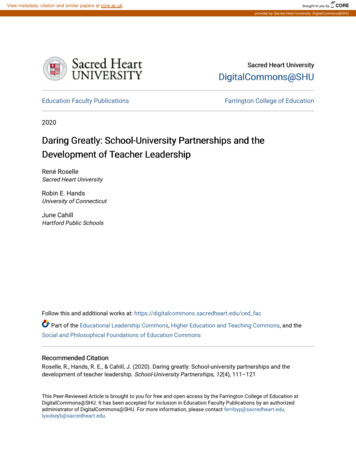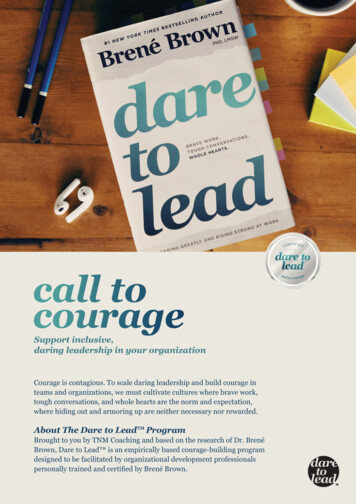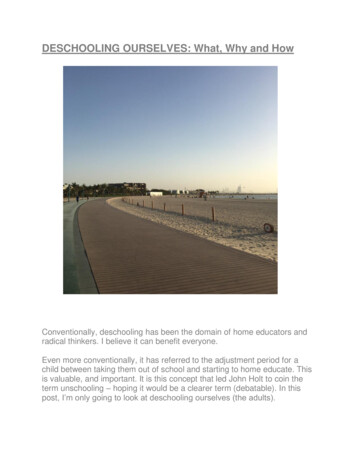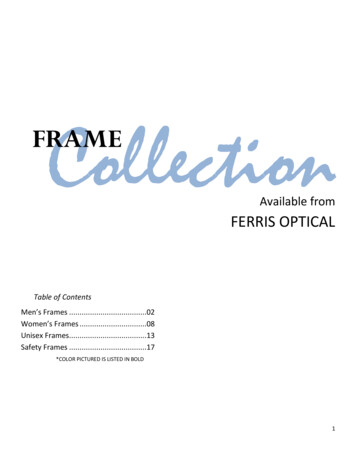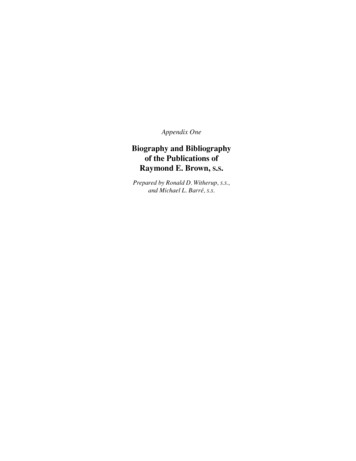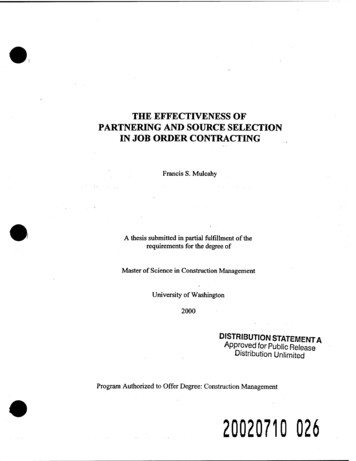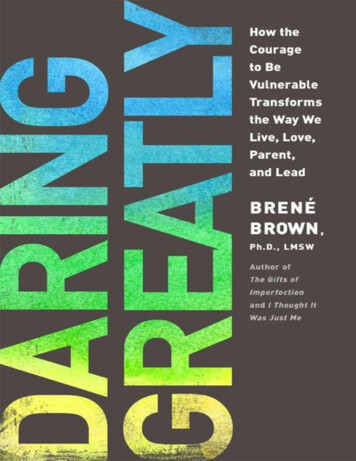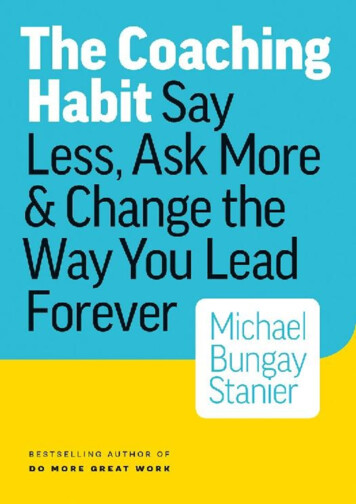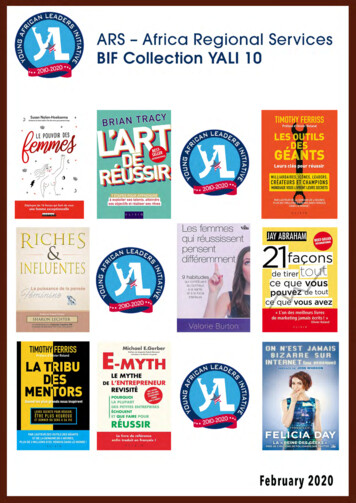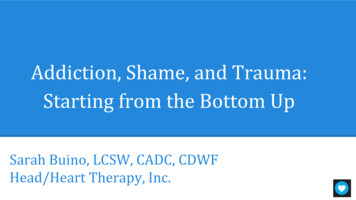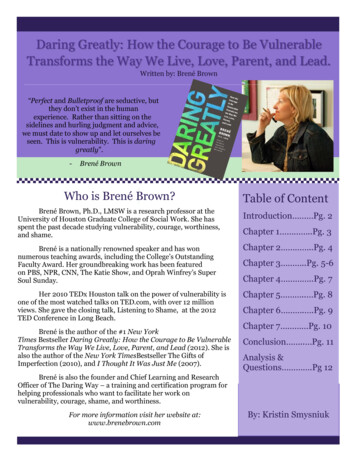
Transcription
Daring Greatly: How the Courage to Be VulnerableTransforms the Way We Live, Love, Parent, and Lead.Written by: Brené Brown“Perfect and Bulletproof are seductive, butthey don’t exist in the humanexperience. Rather than sitting on thesidelines and hurling judgment and advice,we must date to show up and let ourselves beseen. This is vulnerability. This is daringgreatly”.-Brené BrownWho is Brené Brown?Brené Brown, Ph.D., LMSW is a research professor at theUniversity of Houston Graduate College of Social Work. She hasspent the past decade studying vulnerability, courage, worthiness,and shame.Table of ContentIntroduction Pg. 2Chapter 1 .Pg. 3Brené is a nationally renowned speaker and has wonnumerous teaching awards, including the College’s OutstandingFaculty Award. Her groundbreaking work has been featuredon PBS, NPR, CNN, The Katie Show, and Oprah Winfrey’s SuperSoul Sunday.Chapter 2 .Pg. 4Her 2010 TEDx Houston talk on the power of vulnerability isone of the most watched talks on TED.com, with over 12 millionviews. She gave the closing talk, Listening to Shame, at the 2012TED Conference in Long Beach.Chapter 5 . Pg. 8Brené is the author of the #1 New YorkTimes Bestseller Daring Greatly: How the Courage to Be VulnerableTransforms the Way We Live, Love, Parent, and Lead (2012). She isalso the author of the New York TimesBestseller The Gifts ofImperfection (2010), and I Thought It Was Just Me (2007).Chapter 3 .Pg. 5-6Chapter 4 .Pg. 7Chapter 6 . .Pg. 9Chapter 7 Pg. 10Conclusion . Pg. 11Analysis &Questions .Pg 12Brené is also the founder and Chief Learning and ResearchOfficer of The Daring Way – a training and certification program forhelping professionals who want to facilitate her work onvulnerability, courage, shame, and worthiness.For more information visit her website at:www.brenebrown.comBy: Kristin Smysniuk
IntroductionDaring Greatly is a profound read for leaders of all kinds. Whether you are aparent, an educator or a CEO, you are in a position of leadership and as suchhave the ability to be the catalyst for great change. In order to live our best lives,be the best we can be and impact those around us in a positive manner, we mustbe willing to be vulnerable. Vulnerability, in the case of Daring Greatly, is thekey to unlocking a transformative change – not only to the way we live but to theway we parent and lead. It is in vulnerability that we look into the deepest part ofourselves, discover what about the way we live is standing in our way, and maketransformative change in order to begin living the life we not only desire butdeserve.Daring Greatly works to find answers to the following questions:1.2.3.4.What drives our fear of being vulnerable?How are we protecting ourselves from vulnerability?What price are we paying when we shut down and disengage?How do we own and engage with vulnerability so we can starttransforming the way live, love, parent, and lead?2
Chapter 1: ScarcityLooking Inside Our Cultureof “Never Enough”What is Scarcity?Scarcity is the overwhelming feeling of “never enough”. It is a place whereeveryone is overwhelmingly aware of his or her shortcomings and areas wherethey are lacking. It is a space where we live in comparison and competition withothers. We spend time calculating what we have and don’t have and what we stillneed to acquire. One thing that makes scarcity so devastating and self-defeatingis that we are often comparing our lives to fictional accounts of what we believeother’s lives are like.What is the Opposite of Scarcity?What Are We Aiming For?The opposite of scarcity is not about abundance or attaining more than you couldever imagine. Rather the opposite of scarcity is enough. In a society where weare overwhelmed with feeling not good enough, not worthy enough, notskinny enough, not rich enough and not smart enough – we want to reach aplace where we believe, because we know it to be true, that we are enough. Thatexactly as we are, we have something to offer the world. Vulnerability is the keyto getting there.3
ContinuedDuis vel urna at mi consequatcongue. Lorem ipsum dolor sitamet, consectetuer adipiscing elit.Donec ac diam. Pellentesquealiquet. Morbi tempor. Ut id felisnon urna elementum feugiat.Nunc vulputate. Etiam gravidanunc vel tortor. Nulla quis urna.In hac habitasse platea dictumst.Chapter 2: Debunkingthe Vulnerability MythsIn order to live vulnerably, which is to say that we areliving in culture of “enough” rather than "scarcity", itis necessary to unmask the myths that stand in theway of being vulnerable.Duis ullamcorper.“Vulnerability isthe birthplace oflove, belonging,In hac habitasse platea dictumst.joy,atcourage,Morbiurna. Nunc rhoncusmassa.Vestibulumleo. Classempathy, andaptent taciti sociosqu ad litoracreativity.is pertorquentper conubiaItnostra,inceptoshymenaeos.ofDonecnonthe sourcehope,lacus. Nulla facilisi. Duisempathy,fermentumcondimentum lacus.Sedornare. Morbi non felis.accountability,Namandat magna in velit imperdietporttitor. Quisque sollicitudin, duiauthenticity.Ifegetbibendum ultricies, lectusrisusarcu,greatervel ullamcorperweiaculiswantest purus sed nunc. Nulla ac felis.clarityinsodalesoursit amet,Sedligula odio,malesuadain, ultricieseget, dolor.purposeandSed massa. Sed lobortis neque veldeeperandleo.Nullam lacussem,morerutrum eu,sagittisut,ullamcorperut, lectus.meaningfulQuisque uisque ilityisipsumdolor sit amet, consectetuernatoquepenatibuset magnisdisadipiscingelit. Vestibulumantethe path.”(34)parturientmontes,nasceturipsum primis in faucibus orciDonec sit amet nisl blandit nunclacinia porttitor. Sed pulvinarcongue enim.ridiculusmus. Donecaccumsanluctus et Curae; Quisque non lorem at diamrutrumpede. Integera nisi.aliquet viverra.PellentesqueQuisquemi etsenectuspurus.habitant sollicitudinmorbi tristiqueNuncanibh.Fuscenonurna.et netus et malesuada fames acMaurisegestas.faucibusipsumet risus.turpisNullaconsectetuer,massa nec sagittis consequat,Sed posuere lacinia risus.loremultricesmetus, euMaurismassased eratquis liberovarius felis quamut erat.Vivamusvestibulumfacilisis.Sed laoreetrhoncusultricesmassa.Fuscearcu ut sem. Nam a nisi eu orcivariusat sapien.conguenuncporttitor.NullaEtiamodio. Namfacilisissodalesnisi.porta, sapien vitae euismodFour Myths of Vulnerability:1. Vulnerability is WeaknessThe argument is often made that vulnerability equates to beingweak. With weakness often being viewed as unfavorable, it isavoided at all cost. However, at its core, vulnerability is the act offeeling. Everyone feels. It’s part of living. So, to say thatvulnerability is weakness is to say that feeling is weakness. This is adangerous path to go down. In order to live the lives we desire wemust not shy away from feeling for feeling means we are alive.2. I Don’t Do VulnerabilityOften linked to profession or gender, it is here that the practice ofbeing vulnerable is dismissed. Dismissing vulnerability is to avoidit. When vulnerability is avoided it is often done so though engagingin behaviors that are not representations of our authentic selves – theperson we want to be. Vulnerability is life and it cannot be opted outof.3. Vulnerability is Letting it All Hang OutThis myth is centered on the belief that vulnerability means sharingour personal struggles, trials and tribulations with every person weencounter. That it requires an uncomfortable level oftransparency. This is not the case. Instead, being vulnerable is toshare our stories with those who have earned the right to hear aboutthem. It is rooted in relationships of trust.4. We Can Go It AloneGoing it alone is held in very high regard within our society. Pride istaken in the ability to be able to fend for oneself, take care of allissues at hand and anticipate what is ahead with no outsideassistance. However, vulnerability is not the place to ‘go italone’. Support is needed in order to practice vulnerability.4
Chapter 3: Understanding andCombating ShameShame is 1. The fear of disconnection.2. The intensely painful feeling or experience of believing that we are flawed and therefore unworthy oflove and belonging.3. Shame is something we all experience.4. Shame is a real pain and despite what people think emotions can hurt.Three things you need to know about shame:1.- We all have it.2.- We’re all afraid to talk about shame.3.- The less we talk about shame, the more control it has over our lives.Shame Tapes. AKA “The Gremlins”Shame tapes are the dialogues that we have withourselves. They are the repetitive internalmessages that play over and over again telling usthat we are not enough, we are not worthy and weare not capable. When beginning to feelvulnerable our GREMLIN’S act up and begin totell us all the things that we ARE NOT.Ninja Warrior Training:Combating ShameIn order to combat the Gremlin’s weneed to train ourselves to combatshame. The best way to dothis? Develop and practice ShameResilience.
Chapter 3: Continued “Shame resilience is the key to embracing ourvulnerability. We can’t let ourselves be seen if we’reterrified by what people might think.” (61)What is Shame Resilience?Shame resilience is the ability to practice authentically when we experience shame, to movethrough the experience without sacrificing our values, and to come out the other side of the shameexperience with more courage, compassion, and connection than we had going into it. (74)Four Elements of Shame Resilience1) Recognizing Shame and Understanding It’s TriggersIt is important to know when you are in the midst of shame. You have to take the time to feel it,work your way through it and figure out what triggered it. If you can develop a strong sense ofwhat triggers your shame, you will be able to better avoid circumstances/situations where itexists.2) Practicing Critical AwarenessIt is important to look at shame critically in order to helpput it in perspective. Is your shame: Realistic? Attainable?Based on what you need in comparison to what you thinkothers need/expect from you? Practicing shame resiliencemeans acknowledging shame for what it is.3) Reaching OutHere you need to own and share your shame story.Empathy cannot be experienced if you are not connecting with others.4) Speaking ShameSay it out loud. Do not hide in your shame and allow it to take hold. It is necessary to talk abouthow you are feeling and ask for what you need in order to combat the shame you areexperiencing.“A sense of worthiness inspires us to be vulnerable, share openly, and preserve. Shamekeeps us small, resentful, and afraid.” (64)6
Chapter 4The Vulnerability ArmoryVulnerability is scary. For this reason, people spend most oftheir time shielding themselves from it. They dip into theircollection of “vulnerability arsenal” and pull out one of thethree most common forms of vulnerability shields:Foreboding Joy, Perfectionism and Numbing.VULNERABILITY SHEILDSShield #1: Foreboding JoyHere we see a fear of experiencing joy. Living in a world of scarcity leads us to make a connectionbetween joy and vulnerability. By allowing ourselves to experience any form of joy, we are makingourselves vulnerable. So when we feel vulnerable in joy-filled situations we begin to dread joy’scounterpart – pain. So, to lessen the dread of what we view as an impending disaster, we are cautiousabout allowing ourselves to experience joy at all. If we spend our time preparing for the worst, webelieve we will never be disappointed.Shield #2: PerfectionismHere we see the existence of the belief that if we can do everything perfectly, we will never experienceshame. There is vulnerability in feeling imperfect. It comes back to the worry and wonder of whatothers think.Shield #3: NumbingNumbing is the embracing of whatever tactic works to lessen the pain we experience arounddiscomfort and pain. However, it is ever more detrimental because it doesn’t just work to deaden thepainful and difficult situations; numbing vulnerability works to dull the positive experiences as well. Ifwe are numbing vulnerability – or what we see as the experience of or chance at pain and discomfort –we are, along the way, numbing joy, belonging, creativity and love.COMBATING VULNERABILITY SHEILDSHowever, there are ways to combat these shields we get there by Daring Greatly.Daring Greatly to Combat Perfectionism: Practicing GratitudeGratitude is an antidote for Foreboding Joy. When you take time to be grateful for what youhave, you cannot focus on all the things you don’t have or worry about the impending doom of whatcould be. Gratitude leads to feelings of joy as it is the way that we engage in a practice of “enough”.Daring Greatly to Combat Perfectionism: Appreciating the Beauty of the CracksIn order to move away from perfectionism there must be a change in thought process from“what will people think?” to “I am enough”. Living in a culture of ‘enough’ means embracing all thethings about yourself – even the imperfections.Daring Greatly to Combat Numbing: Setting Boundaries, Finding True Comfort and Cultivating SpiritIn order to combat numbing, one must learn how to actually feel their feelings. They need tostay aware of the numbing behaviors that they engage in and they need to learn how to lean into thediscomfort of vulnerability and hard emotions that come along with it rather than find security of thecomfort of their shields.7
Chapter 5Minding the Gap: Cultivating Change andClosing the Disengagement DivideWhy do we disengage?We disengage as a way of protecting ourselves. When we feel that we are getting into a spacethat is too vulnerable, or a space that is full of shame, we disengage. Disengagement is also seenwhen we believe that the people who are leading us (bosses, teachers, religious leaders, parentsor politicians) are not living up to their end of the bargain. Without strong leadershipdisengagement arrives.What is the Disengagement Divide?The disengagement divide is the gap that is present between our “practiced values” and our“aspirational values”.Practiced Values: The things that we ACTUALLY think, do and feel.Aspirational Values: The things that we WANT TO think, do and feel.“Minding the Gap reminds us to pay attention to the space between where we’re standing andwhere we want to go.” (173)8
Chapter 6Disruptive Engagement:Daring to DehumanizeEducation and WorkABSENCE OF CREATIVITYABSENCE OF INNOVATIONABSENCE OF LEARNINGREIGNITING CREATIVITYREIGNITING INNOVATIONREIGNITING LEANING DISENGAGEMENTDISRUPTIVE ENGAGEMENTDisruptive Engagement is working to reignite creativity, innovation, andlearning. How do we do this? We Rehumanize Education and Work! It isnot an easy task. It requires strong and courageous leaders who are willing to putpeople back in the center of the equation. It is about being willing to have openand honest conversations about vulnerability and shame.Ways to Rehumanize Education and Work:1. Combat Shame- “Shame can only rise so far in any system before people disengage toprotect themselves. When we’re disengaged, we don’t show up, wedon’t contribute, and we stop caring.” (192)2. Eliminate Blame- “Blame is simply the discharging of pain and discomfort. We blamewhen we’re uncomfortable and experience pain – when we’revulnerable, angry, hurt, in shame, or grieving.” (195)3. Engage in Feedback- “Without feedback there can be no transformative change. When wedon’t talk to the people we’re leading about their strengths and theiropportunities for growth, they being to question their contributionsand our commitment. Disengagement follows.” (197)9
Chapter 7Wholehearted Parenting: Daring to be the Adults we wantour children to be.Who we are and how we engage with the world are much stronger predictors of how our childrenwill do than what we know about parenting. In terms of teaching our children to dare greatly inthe “never enough” culture, the question isn’t so much “Are you parenting the right way?” as it is:“Are you the adult you want your child to grow up to be?” (215)10
“DARING GREATLY IS NOT ABOUT WINNING ORLOSING. IT’S ABOUT COURAGE. IN A WORLDWHERE SCARCITY AND SHAME DOMINATE ANDFEELING AFRAID HAS BECOME SECONDNATURE, VULNERABILITY IS SUBVERSIVE. IT’SEVEN A LITTLE DANGEROUS AT TIMES. AND,WITHOUT QUESTION, PUTTING OURSELVES OUTTHERE MEANS THERE’S A FAR GREATER RISKOF FEELING HURT. BUT AS I LOOK BACK ON MYOWN LIE AN WHAT DARING GREATLY HASMEANT TO ME, I CAN HONESTLY SAY THATNOTHING IS AS UNCOMFORTABLE, DANGEROUSAND HURTFUL AS BELIEVING THAT I’MSTANDING ON THE OUTSIDE OF MY LIFELOOKING IN AND WONDERING WHAT IT WOULDBE LIKE IF I HAD THE COURAGE TO SHOW UPAND LET MYSELF BE SEEN.” BRENE BROWN11
Critical EvaluationDaring Greatly is a transformative read. There really is no other way to put it. Your view ofyourself, of your profession and of your family will come out dramatically changed though the reading ofthis book. Brené Brown pushes her readers to look inside of themselves and see honestly, likely for thefirst time, the challenging topics that show up in their daily lives. The exploration of self, the practice ofleaning further inward, and the understanding that powerful things await us on the other side is one ofthe great positives of this book. This book is a journey. It could be read and re-read in order to gainfurther insights and move your journey along one step at a time. While the topics/concepts addressedare ones that challenge the status quo of our interactions with not only ourselves but also those aroundus, it is presented in a way that makes it feel achievable. Brown writes as though she is having a personalconversation with you. She is honest about her own shortcomings, shares powerful and at timeschallenging learning experiences with her readers and helps you to see that she is, at the end of the day,on the same journey as us. She is relatable and honest and her integrity shines though in each chapter ofDaring Greatly. I would recommend anyone and everyone BUY this book. Don’t borrow it from thelibrary to read on the weekend. Trust me, you’ll want your own copy. You’ll be making notes in themargins!A Little Time to Think 1. What does vulnerability look like to you?Vulnerability is .2. What are some things you would do if you were not afraid to be seen?3. It is important to have “real” people in the ring with you – people whohave earned the right to hear your story. Who are your people?4. Brené Brown says “you’re only as sick as your secrets”. What secrets areyou keeping because you feel vulnerable?5. What are some ways you could work the practice of gratitude into yourlife? Personally? Professionally?12
Daring Greatly: How the Courage to Be Vulnerable Transforms the Way We Live, Love, Parent, and Lead. Written by: Brené Brown “Perfect and Bulletproof are seductive, but theydon’texistinthe human experience. Rather than sitting on the sidelines and hurling judgment and a
